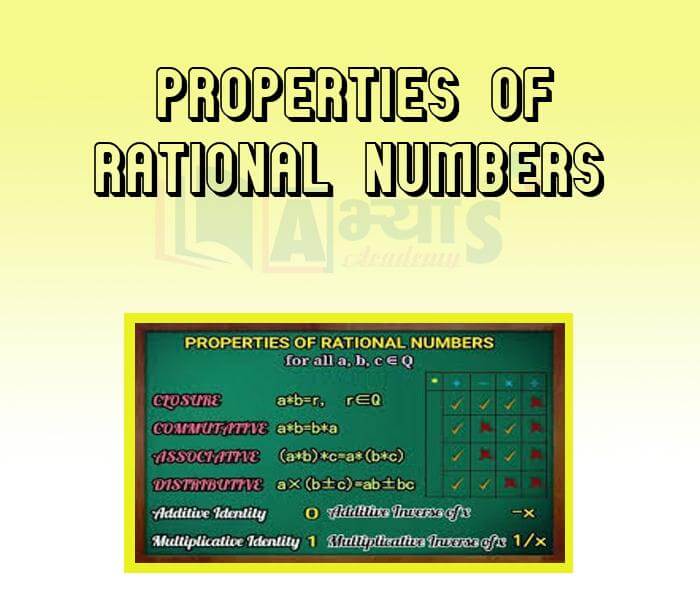Properties of Rational Numbers









Properties of Rational Numbers
Properties of rational numbers are closure property, commutative property and associative property. All these properties have been discussed earlier. Let us briefly describe these properties on the four binary operations (Addition, subtraction, multiplication and division) in mathematics.
Addition
2/9 + (4/9 + 1/9) = 2/9 + 5/9 = 7/9
(2/9 + 4/9) + 1/9 = 6/9 + 1/9 = 7/9
So, 2/9 + (4/9 + 1/9) = (2/9 + 4/9) + 1/9
Subtraction
And, 2/9 - (4/9 - 1/9) ≠ (2/9 - 4/9) - 1/9 . Therefore, Associative property is not true for subtraction.
Multiplication
So, 5/9 x 2/9 = 2/9 x 5/9. Therefore, Commutative property is true for multiplication.
2/9 x (4/9 x 1/9) = 2/9 x 4/81 = 8/729
(2/9 x 4/9) x 1/9 = 8/81 x 1/9 = 8/729
So, 2/9 x (4/9 x 1/9) = (2/9 x 4/9) x 1/9. Therefore, Associative property is true for multiplication.
Division
Distributive Property
1/3 x (2/5 + 1/5) = 1/3 x 3/5 = 1/5 -----(1)
1/3 x 2/5 + 1/3 x 1/5 = 2/15 + 1/15 = (2 + 1)/15 = 3/15 = 1/5 -----(2)
From (1) and (2), 1/3 x (2/5 + 1/5) = 1/3 x 2/5 + 1/3 x 1/5
Therefore, Multiplication is distributive over addition.
1/3 x (2/5 - 1/5) = 1/3 x 1/5 = 1/15 ------- (3)
1/3 x 2/5 - 1/3 x 1/5 = 2/15 - 1/15 = (2 - 1)/15 = 1/15 -----(4)
From (3) and (4),
1/3 x (2/5 - 1/5) = 1/3 x 2/5 - 1/3 x 1/5
Therefore, Multiplication is distributive over subtraction.
Which of the following is example of the Associative Property of Multiplication? | |||
| Right Option : C | |||
| View Explanation | |||
7(a + 1/2) = 7a + 7/2, this is best explained by which of the following property? | |||
| Right Option : B | |||
| View Explanation | |||
This math property states that the sum of two rational numbers multiplied by a number is the sum of the product of each rational number and the number. For example: 4(1/2 + 3/2) = (4 x 1/2) + (4 x 3/2) = _____________________________ | |||
| Right Option : D | |||
| View Explanation | |||
Students / Parents Reviews [10]
A marvelous experience with Abhyas. I am glad to share that my ward has achieved more than enough at the Ambala ABHYAS centre. Years have passed on and more and more he has gained. May the centre flourish and develop day by day by the grace of God.

Archit Segal
7thMy experience with Abhyas is very good. I have learnt many things here like vedic maths and reasoning also. Teachers here first take our doubts and then there are assignments to verify our weak points.

Shivam Rana
7thMy experience with Abhyas academy is very good. I did not think that my every subject coming here will be so strong. The main thing is that the online tests had made me learn here more things.

Hiya Gupta
8thAbhyas Methodology is very good. It is based on according to student and each child manages accordingly to its properly. Methodology has improved the abilities of students to shine them in future.

Manish Kumar
10thOne of the best institutes to develope a child interest in studies.Provides SST and English knowledge also unlike other institutes. Teachers are co operative and friendly online tests andPPT develope practical knowledge also.

Aman Kumar Shrivastava
10thIt has a great methodology. Students here can get analysis to their test quickly.We can learn easily through PPTs and the testing methods are good. We know that where we have to practice

Barkha Arora
10thAbout Abhyas metholodology the teachers are very nice and hardworking toward students.The Centre Head Mrs Anu Sethi is also a brilliant teacher.Abhyas has taught me how to overcome problems and has always taken my doubts and suppoeted me.

Shreya Shrivastava
8thMy experience was very good with Abhyas academy. I am studying here from 6th class and I am satisfied by its results in my life. I improved a lot here ahead of school syllabus.

Ayan Ghosh
8thAbhyas is a complete education Institute. Here extreme care is taken by teacher with the help of regular exam. Extra classes also conducted by the institute, if the student is weak.

Om Umang
10thIt was a good experience with Abhyas Academy. I even faced problems in starting but slowly and steadily overcomed. Especially reasoning classes helped me a lot.
